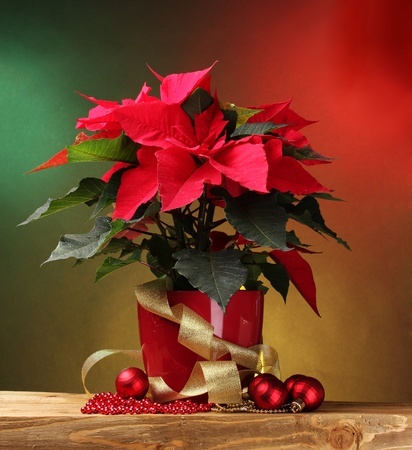Poinsettias are the traditional houseplants that adorn our Christmas floral displays. They are more properly called Euphorbia Pulcherrima and are members of the Spurge family. They are indigenous to Mexico and Central America in the deciduous tropical forests.
The common English name Poinsettia is derived from the name Joel Roberts Poinsett who was the first U.S minister to Mexico, and introduced the plant to America in 1825.
What we think of as the flower heads are actually coloured bracts or modified leaves. The actual flowers are the small Yellow structures in the centre of the bracts. This is useful to know when purchasing a Poinsettia as the tighter the flowers are in the centre, the fresher the plant and the longer the coloured bracts should last. The bracts are traditionally red for Christmas, but are also available in Pink, White and Marbled.
Growers could produce a new batch of poinsettias weekly throughout the year by imitating their natural conditions. However, the public generally only demand new plants around the Christmas period, so they are only grown at this time. They are given long dark nights in the autumn by using blackout screens in the greenhouses, followed by bright days for around two months so the bracts colour up.
As for how to care for your plant once purchased, give it a warm room at a minimum of fifteen degrees centigrade or fifty- nine degrees fahrenheit in good light but not direct sunlight. Avoid cold draughts. The leaves will benefit from misting to imitate its tropical origins. Allow the compost to become moderately dry between watering and if the plant is stood in a pot cover, ensure the pot cover does not fill up with water causing overwatering.
Always purchase your poinsettia from indoors. Never buy a plant that has been left outside in icy conditions as this is a sure-fire method for failure. With the proper care plants can be colourful right through to Easter. Many or our Poinsettias are grown in the Netherlands. However, it is often said that British grown plants, which are grown at slightly lower temperatures, are more suited to our environment.
If broken the plants will exude a white latex. This can cause allergic reactions to sensitive skin. Plant problems that can occur include mealy bug and Red spider mite. However, it is rarely necessary to spray as the plant is used as a short-term pot plant, and significant problems are unlikely to occur in that period.
Poinsettias can be propagated from stem cuttings in early summer. Also existing plants can be forced to re-flower by artificially controlling the day lengths in autumn by putting in a dark cupboard or covering with a black polythene bag for certain periods. This is however a long and laborious process. Also the plant, which has been artificially shortened in height by the grower using chemicals, will naturally become taller in successive years. I would therefore recommend that you discard the plant after it has ceased to become decorative, and buy a new one the following year, helping to keep the nursery industry afloat.
Other than that simply enjoy their beauty that has become an integral part of our festivities.
To view the range of Christmas plants and gifts at Thompson and Morgan click here
Mark Snelling.
If you have enjoyed reading our blog post then why not fill in the form provided to allow us to send you our blog posts and newsletters by email.

